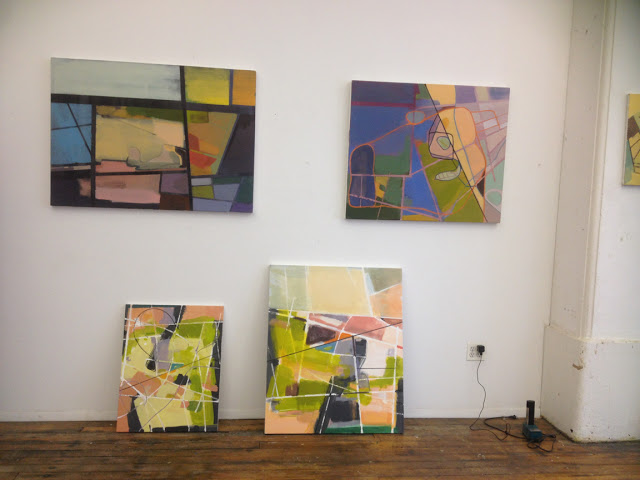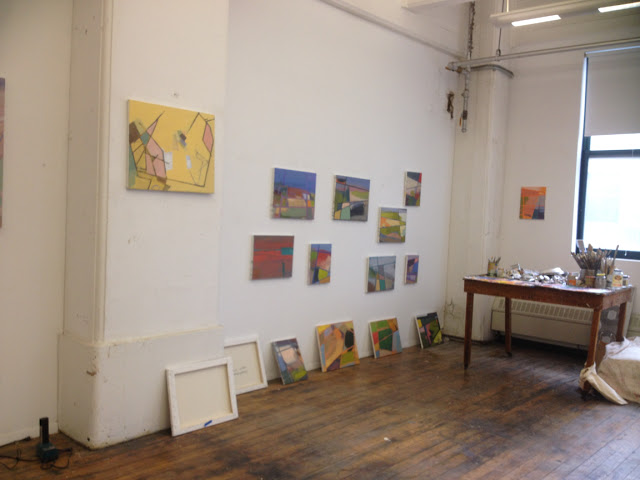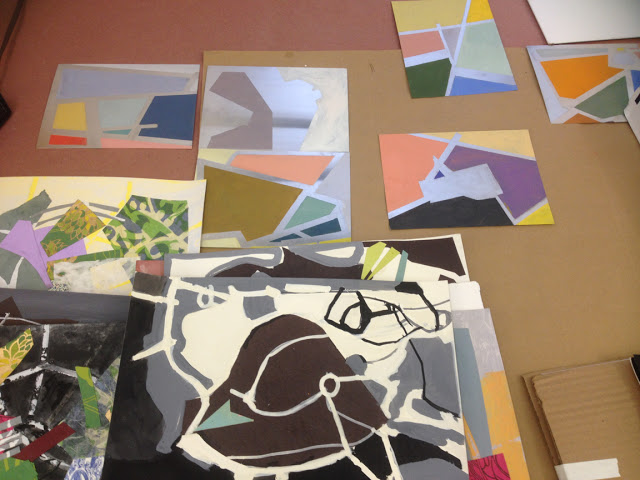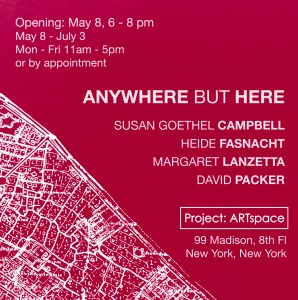Recently stopped by Elizabeth Hazan‘s studio to check out her glowing new abstractions–lyrical paintings that reference the landscape of her childhood. We talked about her process, color strategies, surfaces, and what it was like growing up with notable New York School painters Jane Freilicher and Joe Hazan as parents. They divided their time between Manhattan and Water Mill, a town on the eastern end of Long Island where the farms and open fields that were so familiar to Hazan have begun to disappear.
Two Coats of Paint: You have a lot of new work! I’m struck by your excellent eye for color relationships. Tell me about the color choices and your process.
Elizabeth Hazan: When I originally started painting abstractly, I intentionally reduced my palette. At that point I was painting trees, largely from photographs and I loved the emulsion. I started doing ink drawings– isolating sections, pixelating spots, and painting them. It wasn�t a conscious move away from representation at all, more that I followed where the work took me. I looked a lot at Mondrian, making the work more geometric. As much as I tried to be reductive, I was producing very busy pictures. The ones in which I tried to tamp down my natural exuberance were pretty dull, I have to admit. This was 2007-10, I had an idea that I would use seven or eight colors, like a music scale, like jazz variations. They were bright, but they were limited in terms of the palette. I�ve been thinking a lot about editing, how learning to edit your own pictures is a hallmark of making more mature work. Some people, like Alex Katz apparently are born with the eye for it. It�s something artists have in common with writers, how much of the work is in the editing.
[Image at top: Elizabeth Hazan, Jamaica Bay, 2016, oil on canvas, 47 x 50 inches.]
A lot of these new paintings are from memory. I have painted aerial views for a while. Even when they were more geometric, I had an implied horizon line and things would disappear and come forward from the horizon. I painted one painting that kind of shifted to an aerial perspective and tilted down, and since then I�ve been doing that. I come at it different ways�some collage-based, some linear approaches, some based on printed maps and some on Google Maps. The aerial vantage point has become increasingly widespread as technology allows it. Google Earth has spawned a lot of art. I like to hover over the world and apparently a lot of other people do too.
I took four months off last year to work on my mother�s archive�all her papers, photographs and letters ended up at Harvard University. It was a terrific experience, and I wondered how it would affect my work. When I came back to my studio, the effect of spending time sifting through so many other artists� lives, kind of distilled things: what do I really want my paintings to do. Also, selling her house on Long Island has had a big impact, bringing up a lot of memories. I felt like I�ve entered a kind of dream space.
TCOP: Your parents lived through an amazing time. When I read about art communities from the past, no matter where they are�New York in the 1950s, Paris in the early 1900s– I feel as though our own era pales in comparison. They probably felt the same way about earlier generations.
EH: Well, I had a child�s eye view of the art community back then. Strong impressions that aren�t necessarily accurate. Being in Fairfield Porter�s or de Kooning�s studio as a kid is much different than as an adult. My parents were known for throwing parties. I remember sitting behind the Christmas tree at one, watching, and someone coming to sit on the floor back there with me. But what really struck me were memories of the land itself out on the east end of Long Island. We used to wander back then, run through the fields, roam freely. Now the landscape is all built up, full of hedges. I�m exploring what I remember. I can look at Google Maps and still see the fields that aren�t visible from the road. As an adult you don�t even know they are there. I think about how visual representations, digital images, affect our memory of a place. How does seeing an image before hand on our phones or gps affect our experience when we get there? What do we retain?
TCOP: So you are piecing together the landscape as you remember it?
EH: Well, in the small paintings, yes. I�m not trying to describe a specific place, more that I�m trying to invoke a response that I�ve had. To recreate that experience for the viewer. The larger paintings are more of a combination of maps and memory, different sources.
TCOP: I love the way you�re using the masking tape. When you get close to it, the shapes and lines have a roughness.
EH: I love the warbles from the tape. I�m trying to see how rich I can get it.
TCOP: The edges have a delicate handmade quality. What about the color? This summer I worked on a batch of color studies based on Goethe�s triangle. I�m not a colorist so I�m always looking for new ways to approach it. How do you manage color?
EH: I mix and respond as I go. I used to pre-mix all the colors in jars and use a controlled palate as I said. Now, depending on the first area I do, which may just be a response to some color that has caught my eye or stayed with me from another painting, then I choose the next colors based on that one, a little like the butterfly effect in nature, cascading responses, I try to develop color relationships in the process, and sometimes I go back and correct. I don�t use color out of the tube, I mix everything.
TCOP: The surfaces look very dry. Do you just mix the oil paints with turps?
EH: I have 1/5 poppy or walnut oil.
TCOP: No linseed?
EH: No. I�ve heard it yellows.
TCOP: So you think these materials are more stable.
EH: I don�t know. I like talking to people at the paint companies�Gamblin and Golden. They are very helpful, and they love to talk. They always recommend something. I tell them what kind of surface I want and they tell me what to use.
TCOP: I�ve been using the standard 1/3 mix�turps, varnish, linseed oil, but there was a period when I varied quite a bit from that. There are so many different kinds of surfaces. Don�t you think how we mix our paint places it in an historic context? When I first started painting, painters were using a lot of drippy pentimenti. They wanted to be able to see the early layers in order to reveal the process. Now surfaces are much drier and flatter, sort of like easel paintings from the 1940s.
EH: I was looking at one of Janet Fish�s 1960�s paintings yesterday and it had a beautiful, rich shiny surface. That�s why people used varnish in their medium�it always looks so fresh. I tend to like it matt with a hint of luster.
TCOP: Is this one done?
EH: This is the oldest in the series. It�s based on an image of a flooded landscape.
TCOP: These new ones look great. The lines aren�t lying flat. They look a little sculptural�as if we are looking at an object rather than a flattened grid.
EH: I like finding a balance between the flat geometric planes and the illusion of landscape. I�m also thinking about line and form. The line takes your eye around the picture and sustains the form like arteries.
TCOP: You�re interested in both the structure and the color. Some artists are interested in color and others in structure, but rarely both equally.
EH: A lot of people who come out of the Studio School have a thing for drawing. I definitely think structurally. This one was in the collage show at Morgan Lehman. When I came back in the fall, I made this one�it�s almost like water color, or like a Marilyn Minter. I began layering the tape at both the beginning and the end of the process. I started using the paint much more loosely, I felt like I was being seduced by the tape and now I�m using it more judiciously. It was the first time the tape did this thing.
TCOP: I love the layering of the lines and the shallow ambiguous space they create. They make sense in terms of landscape. Are you thinking about seasons? Or do you think you�re moving from landscape to pure abstraction?
EH: No I�m not consciously thinking of seasons, but maybe it affects the color. I�m thinking about building my vocabulary. Geometric relationships serve as constellations and building blocks, so I want to retain some of those. There are references to roads, buildings, and so forth. There is a back and forth between man made systems, whether real or digital, and then the natural landscape.
TCOP: I�ve always wondered what must be like to have a mother who is a painter.
EH: We don�t have enough time for that discussion! My mother was extraordinary in so many ways. She was very supportive but we didn�t talk much about art. Maybe the most important influence was just observing her intuitive approach. I once read that Eric Fischl said he became an artist because his parents didn�t know anything about it. And I thought Oh! What a great idea! My dad would have loved it if I had been a doctor or something useful, because they knew so many artists and felt that the world didn�t really need any more. I originally started out in film, and it wasn�t at all like I thought it would be. I preferred working alone in the studio to working on a film set.
TCOP: When you started painting, did you feel like you had to have something major to say in order to make painting worthwhile? Did you feel you had to top your parents and their generation?
EH: Oh god no. I just took the plunge. It was important to me to make work that wasn�t derivative, especially of my mother�s work. At the Studio School, I studied with Esteban Vicente, who really talked about color, Nick Carone, Ruth Miller. Robert Storr was the Acting Dean and taught a theory seminar, then Graham came in as Dean and started the Drawing Marathon. I studied with Elena Sisto, Glenn Goldberg, a real wide range of faculty. I started out looking at Albert York and making little still lifes, not the big messy undergraduate paintings most people begin with. Those came later when I went to Skowhegan. I worked at Robert Miller and I was often there after hours, so I got to really spend time with great paintings�early Alex Katz, Al Held, Milton Resnick, Joan Mitchell. It makes such a difference when you can spend time with other painters� work. My mother was adamant that painting is a slow process, that you can�t rush into anything. I�ve always felt that it�s important to move slowly. Developing your own language takes time.
Related posts:
Elizabeth Hazan: A drawing’s path
Elizabeth Hazan and Jennifer Riley at Janet Kurnatowski
——
Two Coats of Paint is licensed under a Creative Commons Attribution – Noncommercial-No Derivative Works 3.0 United States License. To use content beyond the scope of this license, permission is required.






















Insightful observations!!!! Thankyou—-poul
Pingback: Art & Craft features Elizabeth Hazan – What Would Virginia Woolf Do?